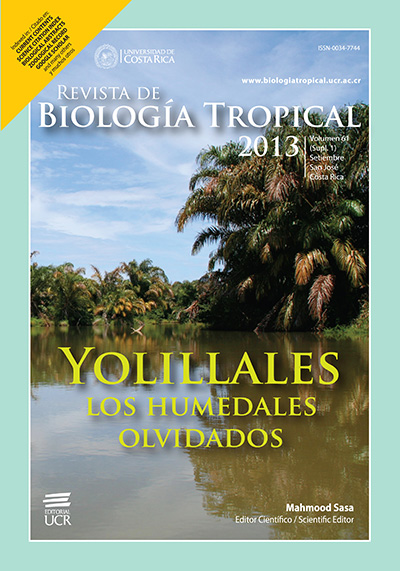Abstract
In the marshes dominated by palms, seeds face anaerobic substrates and long flooding periods. Some tree species are capable of growing both in flooded swamps and in areas with lower influence of the flood. I studied the potential settlement of various tree species in different macrohabitats in the Tortuguero floodplain using three experiments: (1) Manicaria saccifera and Raphia taedigera seed germination in palm-swamps and forests of slopes; (2) germination of R. taedigera seeds along a microtopographic gradient; and (3) seed germination and seedling height growth of six woody species (Dipteryx oleifera, Pterocarpus officinalis, Prioria copaifera, Pentaclethra macroloba, Carapa guianensis and Crudia acuminata) and two palms (R. taedigera and Manicaria saccifera) under different forest and swamp habitats. In the first experiment, I found that the palms germinated much earlier in the slope forest than in the palm-swamp. In the second experiment, in drier plots (less effect of flooding) germination began earlier than in the more humid plots. In the third experiment, woody species germinated faster than the studied palms, and some species do not tolerate flooded areas (marshes and swamps), so they cannot germinate or survive in them. Other woody species were removed from the slope forest, probably due to seed predators. Based on the presence or absence of these species in the environment of study were divided into: (1) obliged swamp species (R. taedigera and M. saccifera), (2) swamp intolerant (D. oleifera), and (3) facultative wetland species (P. officinalis, P. copaifera, P. macroloba, C. guianensis). Crudia acuminata does not seem to follow any of these categories.
References
Holdridge, L.R., W.C. Grenk, W.H. Hatheway, T. Liang & J.A. Tosi Jr. 1971. Forest environments in tropical life zones: a pilot study. Pergamon, Oxford, Inglaterra.
Janzen, D.H. 1970. Herbivores and the number of tree species in tropical forests. American Naturalist 501-528.
Janzen, D.H. 1974. Tropical blackwater rivers, animals, and mast fruiting by the Dipterocarpaceae. Biotropica 6: 69-103.
Janzen, D.H. 1978. Seeding patterns of tropical trees, p. 83-128. In P.B. Tomlinson & M.H. Zimmermann (eds.). Tropical trees as living systems. Cambridge University, Nueva York, EE.UU.
Myers, R.L. 2013a. Humedales dominados por palmas (Arecaceae) en el Neotrópico: Una introducción. Rev. Biol. Trop. 61 (Supl. 1): 5-24.
Myers, R.L. 2013b. Remoción y dispersión de semillas en un humedal dominado por palmas (Arecaceae) en el noreste de Costa Rica. Rev. Biol. Trop. 61 (Supl. 1): 67-85.
Rabinnowits, D. 1978a. Early growth of mangrove seedlings in Panama, and an hypothesis concerning the relationship of dispersal and zonation. J. Biogeography 5: 113-133.
Comments

This work is licensed under a Creative Commons Attribution 4.0 International License.
Copyright (c) 2013 Revista de Biología Tropical






